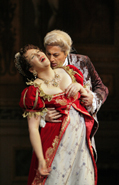 Jealousy, the Undoer
Jealousy, the Undoer
In the first act of Puccini’s Tosca, the painter Mario Cavaradossi and his lover, singer Floria Tosca, squabble over her jealousy. His painting of Mary Magdalene in the church has filled her with doubts over the fidelity of the painter’s heart. Tosca’s jealousy distorts her actions and what she senses around her—voices talking in the empty cathedral become the murmurings of lovers. She understands her jealousy as a torment, not only for Mario but also for herself, and the liquidity in her control of jealousy is what keeps the character from melodramatic shallowness.
Even more, jealousy is the fourth character in the interplay between the three individuals who drive the action of the opera: Cavaradossi, Tosca and the corrupt police chief Scarpia. And jealousy can only be a dark and monstrous character.
Watching the San Francisco Opera’s opening production of Tosca this past Tuesday, I was plagued with regret for the impossible—I wanted to see Maria Callas in the role, someone who could conjure up and be possessed by the variable darkness of jealousy.
While soprano Adrianne Pieczonka is a wonderful singer, vocally powerful and tonally beautiful, she lacked the obsessive grandeur of heated passion—the sense of the singer pierced to the heart and struggling to free herself of her own emotions—that would give the role and the opera the punch that it needs.
Take the moment in the first act, when Scarpia gives Tosca the fan that belongs to the Marchesa Attavanti, the model for Cavaradossi’s painting of Mary Magdalene, claiming that it was dropped by the marchesa when she and the painter hastened off to their love nest. That is the turning point, really, of the opera’s action. The director, Jose Maria Condemi, has Tosca throw the fan at the painting; Pieczonka’s fling of the fan should have had the vehemence of a thrown knife, rather than the girlish lob she made, which was simply unconvincing. That single moment sums up the production’s overall weakness.
Within that theatrical weakness, however, there were moments of musical loveliness, including Pieczonka’s warm and fluid performance of “Vissi d’arte, vissi d’amore” (I live for art, I live for love).
And jealousy, the undone
Baritone Lado Ataneli’s portrayal of Scarpia was spot on, though. Like Tosca, Scarpia is ruled by dark passion—a sexual passion for Tosca coupled with jealousy of Cavaradossi and sadism. Again, the character’s struggle to contain that passion drives the action. It is this tenuous mastery of the impulses of an outlandish desire that Ataneli projects. There is a stillness in his movement that befits the blackness of his costume and his motivations and that suggests seething emotions barely held in check. Add to this tension a resonant baritone with a darkish timbre, and you evoke levels of inchoate villainy that strike fear into the onlooker’s heart.
Carlo Ventre seemed caught between the two portrayals in his realization of the idealistic and brave painter. He was most effective in act 3; his understanding of “E lucevan le stele” (And the stars were shining) swung more to the contemplative and tender than to the fervent and despairing, which was plausible given his more subdued, perhaps refined, version of Cavaradossi. But he was not helped by stage direction that had him, among other things, flinging himself face down after the aria, a melodramatic and theatrically dubious gesture compared to the delicacy of the interpretation.
Other moments of strength in the production included Ataneli’s “Va’ Tosca” (Go, Tosca) a well-paced vocal and orchestral crescendo during the chorus’ “Adiutorium nostrum” (My help is in God’s name) and Scarpia’s aria “Adoppia mira tendo il voler” (At two goals I aim my desire), the naked male caryatids in Scarpia’s apartments in the Farnese Palace, San Francisco Boy Chorus member Zachary Weisberg’s aria as the shepherd boy, the Adler fellows (of course!) and excellent orchestral support throughout. Marco Armiliato was the conductor.
—Jaime Robles
Originally published in the Piedmont Post
Photo: Adrianne Pieczonka as Tosca and Lado Ataneli as Scarpia. By Cory Weaver
